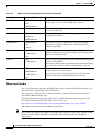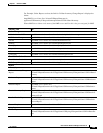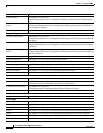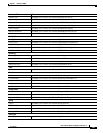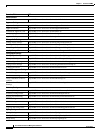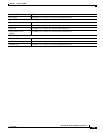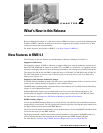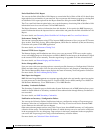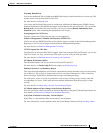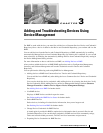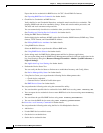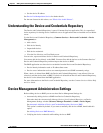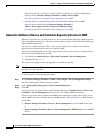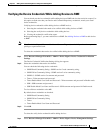
2-2
User Guide for Resource Manager Essentials 4.1
OL-11714-01
Chapter 2 What's New in this Release
New Features in RME 4.1
End of Sale/End of Life Report
You can use the End of Sale/End of Life Report to ascertain the End of Sale or End of Life details that
impact the devices and modules in your network. You can generate this Inventory report by selecting End
of Sale/End of Life report option from the Report Generator dialog box under RME Reports.
The Cisco.com Fetch Interval option helps you to set the frequency of retrieving End of Sale/End of Life
information from cisco.com and store it in the RME database.
The Report Generator, retrieves information from this database. It also queries the RME Inventory to
retrieve information about the impacted devices and modules and generates the End of Sale/End of Life
Report.
For more details, see Generating End of Sale/End of Life Report and Cisco.com Fetch Interval.
Performance Tuning Tool
You can tune system parameters using PTT to improve RME performance. Now you can use PTT to tune
Sync Archive, NetConfig, Syslog, Device Management, Check Device Attributes (CDA) and Inventory
Collection sub systems of the RME application.
For more details, see Performance Tuning Tool.
External TFTP Server Support
The Remote Staging and Distribution now allows you to use an external TFTP server as the staging
server, to distribute images to all the devices available in RME. First the image to be distributed is staged
to the external TFTP server manually. Then the staged image is upgraded on all the selected devices.
For more details, see Remote Staging and Distribution.
Device Manageability Status
Now you can use this new reporting option to ascertain possible Inventory or Configuration Collection
Failure and take timely actions. You can select the required devices and generate an immediate report.
This Device Manageability Status report displays the status of Inventory and Configuration Collection.
For more details, see Device Manageability Status.
Dual Supervisor Support
RME Software Image Management now supports upgrading both active and standby supervisor engines
or route processors for the following devices: Catalyst 4500, Catalyst 6500 (running Cisco IOS/Cisco
IOS Software Modularity), Cisco 7600 Routers, Cisco 10000 Routers.
Secondary Credentials Fallback
The Secondary Credentials page available under System Preferences tab of RME Admin allows you to
enable or disable fallback to secondary credentials when authentication through Primary Credentials is
not successful.
For more details, see RME Secondary Credentials.
Notification on Inventory / Configuration Failure
You can use the Collection Failure Notification window to configure the receipt of Trap messages on
Inventory Collection or Configuration Fetch failure. This Trap is sent for each device from the RME
server whenever the collection does not happen.
Other network management stations can use this Trap to know about RME Inventory or Configuration
collection failure status. The destination IP address to which the traps are to be sent can be configured
in the env.properties file. Any third party Trap receivers in the host(s) mentioned in the env.properties
can receive the Trap messages on Config collection/Inventory collection failure.
For more details, see Collection Failure Notification



